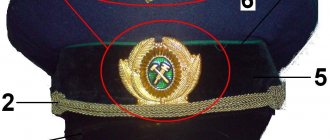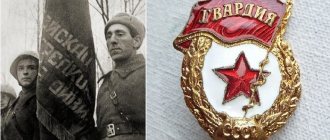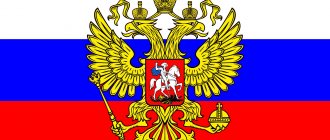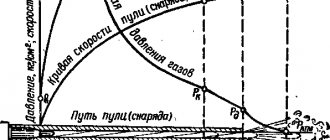Ukraine is a government located in Central and Eastern Europe, with a population of about 42 million people and a territory of 576.6 thousand square meters. km. (without Crimea). The capital of the country, the city of Kyiv, became the capital of the Old Russian country from the 9th century (after the end of Novgorod) and remained in this capacity until the end of the 13th century. Later, the modern territory of Ukraine was divided between adjacent countries. Separate parts of it were at times passed from one neighbor to another.
This is what the modern flag of Ukraine looks like:
History of the flag
The modern flag of Ukraine was first used in June 1848 in Lviv, which was then part of the Kingdom of Galicia and Lodomeria. After the end of the revolutionary events in Austria-Hungary, in its Ukrainian part there was also a movement of resistance. The self-government body Russka Radostna was created in the city of Lvov. While resolving the issue of a flag, which did not yet exist at that time, it was decided to take the colors from the coat of arms of the Lviv land as the base (one of the guesses).
The introduction of yellowish and azure colors correlates with the colors of the coat of arms of the Lviv (Leopol) land. The first documentary evidence of this fact dates back to the period of the “Great War” of 1409-1411, at that time, at that time, at that time, at the time when units from the Lviv lands, using the banner, took part in battles with the crusaders. the azure background of which depicted a golden lion climbing a mountain. Later, this banner was taken as the basis for the coat of arms of the Russian Voivodeship, which existed in the 15-18 centuries as part of the Polish kingdom.
- Coat of arms of Lviv lands
- Coat of arms of the Russian voivodeship
Later, yellow and blue colors appeared on the country sign in 1917-1918. Then two options were approved. The difference between these options was not in the color palette, but in the sequence of their implementation:
- The blue and yellow look is the sign of the Western Ukrainian People's Republic (WUNR). This species was a sign from June 1917 to 1920. During this short gap, there were such territorial subjects as the Ukrainian Autonomy within the Russian Federation, the UPR, and the Western Ukrainian People's Republic. The same version of the flag was adopted in the first half of the 40s of the twentieth century as the flag of the Ukrainian municipal government. This formation had a temporary status and after its abolition, a second governing body was created - the Reichskommissariat.
- The yellow-blue look is the sign of the UPR (eastern part of the country).
The flag of the Western Ukrainian People's Republic was later (1991) approved as the official sign of modern Ukraine.
From the history of the country, we know that the municipal sign did not always have its current blue and yellow appearance. Depending on the period of time or form of statehood, he changed his personal colors or non-specialized appearance a couple of times.
Parallel to the blue and yellow banners there was also a banner denoting belonging to the country of the Soviets. So, after the establishment of Russian power in December 1917, the UPR of the Soviets was proclaimed and personal symbols were adopted.
Just over two months later in March 1918, following the results of the Brest-Litovsk Peace Treaty, the Ukrainian Ukrainian Socialist Republic ceased to exist.
During the civil war in Ukraine, rebel armies of various kinds also operated. the most famous of them is the army of Nestor Makhno, who tried to organize the “Free Territory” - an anarchist society. Variants of black flags with a skull or a slogan about anarchy are attributed to the designated army.
In the periods from 1919 to 1929 and from 1929 to 1937, the Russian Socialist Republic with its own attributes was created on the Ukrainian part of the area remaining in the USSR. In the first case, it was a red banner with the abbreviation U.S.S.R.
In the 2nd case - U.S.R.R. (the abbreviation is made up of the same words but in Ukrainian “Ukrainian Socialist Radyanska Republic”).
From 1937 to 1949, the inscription on the flag of the republic was not altered enough and the flag looked different. In this version, the third and second words of the Ukrainian name have swapped places.
Since 1949, the flag of Ukraine was again modified according to the uniform example of the second flags of the republics of the USSR. Two-thirds of the width of the flag was red, and 1/3 of the flag (bottom) was blue. This option existed until the collapse of the USSR in 1991.
The golden-blue coming of the Trypillians
Since ancient times, different peoples have used certain symbolism in battles to mark the location of warriors. As a rule, these were pieces of rectangular or triangular-shaped fabric that were attached to spears.
In Kievan Rus, images of Christian saints were most often used. Later, the coats of arms of various lands began to be approved, which formed the basis for the formation of modern national symbols.
Similar gold-blue symbolism was once brought by the Trypillian people during the migration of peoples. Some of the settlers left the Northern Black Sea region 5000 years ago. Ancient India was chosen as a new habitat, where symbolism still remained in its original form.
The meaning of the colors and sign of the flag
The state symbol of Ukraine has no official interpretation. Over time, the designation of colors changed depending on political fashion or the tastes of contemporaries. Among the interpretations there are those of a sacred nature, sacred, symbolic, and light. Among the color meaning options are the following:
- Blue is a clear, colorful sky, yellow is ripe wheat fields. This is the most popular interpretation.
- Two elements: blue - the element of water, yellow - the element of fire.
- Blue is the power of the Almighty, yellow is the power of faith.
- Blue - everything Earthly, yellow - Basic spirituality.
- Blue - rivers and mountains, yellow - historical memory of Kievan Rus.
- Blue - passivity and conservatism, the need for spirituality, yellow - active, creative.
Supporters of the inverted yellow-blue flag also have their own interpretation. Yellow is the golden domes of Orthodox churches, blue is the waters of the Dnieper.
White-red-white symbols were used by the Belarusian military
The white-red-white flag appeared about a hundred years ago. It has become a symbol of the Belarusian national movement since the late 19th and early 20th centuries. As Vladimir Lyakhovsky, associate professor of the Faculty of International Relations at the Belarusian State University, points out, the creation of their symbols for most countries of Central and Eastern Europe began with the “Spring of Nations” and was finally consolidated at the end of the First World War, when multi-ethnic empires were destroyed and separate states were created. By the beginning of 1916, there were from 1 to 1.5 million Belarusian refugees in the Russian Empire who had left the territories that were to be occupied by the Kaiser’s troops. Among them were many Belarusian political figures. “At semi-legal meetings, they discussed the fate of Belarus before the February Revolution in the context of what needs to be done to consolidate the Belarusian political elite,” the historian says in an interview with DW.
At the same time, the first attempt was made to create a draft of the Belarusian national flag. Architect Leon Dubeykovsky believed in 1916 that the colors of the flag should be traditional “common Slavic”. These are red, white and blue, which, as Vladimir Lyakhovsky explains, among the Serbs, Slovenes, Croats, Czechs and Slovaks refer to the ideas of the Great French Revolution. But this idea did not take root.
Minsk, 1918: white-red-white flag on the building of the People's Secretariat of the BPR
During the February Revolution, when national formations began to be created, Belarusian officers and soldiers at the fronts and the Baltic Fleet increasingly used white-red-white ribbons on their uniforms, which distinguished them from representatives of other nationalities of the former tsarist army. The order to develop a sketch of the national flag came from the Belarusian military committee in Petrograd. By the summer of 1917, a mining engineer and architect, a student at the Petrograd Mining Institute, and later one of the founders of the Belarusian People's Republic, Claudius Dushevsky (Duzh-Dushevsky), combined white, red and white stripes on the panel.
Ukraine flag with swastika
There is no data in official Ukrainian history confirming the introduction of the blue and yellow state sign along with the Nazi swastika.
The yellow-blue cloth is another matter. It was used in the environment (district) of Galicia - an administrative-territorial entity in 1941-1944. on the territory of occupied Poland.
Archival historical records say that this version of the banner was used by Galician volunteers and policemen. The Austrian Hitler did not directly prohibit the introduction of a variant of the Ukrainian flag, which on the one hand symbolized the return of Galicia to Austria, i.e. Germany, in another case as a prize to Ukrainian nationalists for their devoted work to the Reich. In the first half of the 40s of the twentieth century, the SS rifle division "Galicia" was organized, whose fighters used this banner.
During the 2nd global war, other national symbols were banned in Ukraine and only the German symbol of that time was used - a red banner with a black swastika on a white background in the center.
Then, on the territory of some occupied Poland and Ukraine and regions of Belarus, the Reichskommissariat of Ukraine was created (1941-1945). Organizations of Ukrainian nationalists (OUN), both the Bendery and Melnikov wings, did not use swastikas on their own banners.
during the events that began in Ukraine in 2013-2014. and subsequent military actions, individual adherents of fascist ideology used a variant of the banner with a swastika. Some of them dreamed of creating a 4th Reich in Ukraine. But these facts have nothing to do with state symbols. All other options for combining the current state sign of Ukraine with a swastika, which are available on the Internet, most likely belong to the category of Internet memes.
Celebration
Ukrainians celebrate Flag Day on August 23, and recently submitted for approval a draft decree regulating the introduction of the Day of the National Anthem and Emblem of the state. This is an important step to popularize patriotism among the population. At the meeting, officials proposed setting the date for celebrating the National Anthem Day on March 10th. In this way, the popularization of the paraphernalia of power will be introduced not only within the country, but also among representatives of Ukrainian diplomatic institutions in neighboring countries.
Attention was focused on disseminating information about the national emblem and flag through the media, and funds were allocated for the launch of social advertising. It is proposed to introduce lessons in educational institutions to instill in the younger generation a respectful attitude towards state attributes. Deputies call for popularizing national symbols on the Internet, as well as developing a resource for distributing emblems of national identification of Ukraine.
Previously, the Ukrainian Institute of National Remembrance put forward a proposal to establish the celebration of Anthem Day on March 6. Why this particular date? Many years ago, on March 6, the Ukrainian anthem was played for the first time! Now all that remains is to decide on the development of a large coat of arms, launch the project and set a day to celebrate this day. It is assumed that this will be the red number of the calendar, that is, Ukrainians will receive an additional day off.
Other flags
Throughout the history of the country, depending on the historical era, different signs were used in Ukraine, which corresponded to the political situation of a certain time. For example, in the first half of the 20s of the twentieth century, in the region of the Far East of the Russian Federation on the border with China, an attempt was made to create a sovereign territorial entity. Its name was Green Ukraine. The people used the name Trans-Chinese. A version of the proposed flag was created for this entity, but the plans of the Ukrainians were not realized and education did not materialize in the first half of the 20s of the twentieth century.
With independence gained at the end of 1991, the “flag” leapfrog was streamlined and in modern Ukraine, each national entity has its own symbols. Eg,
- standard of the President of the country;
- General Staff;
- armed forces;
- Air Force;
- naval, etc.
Any of the heads of state structures have personal personal flags (samples). Eg:
- Minister of Defense,
- naval commanders,
- State Guard, etc.
Modern coat of arms
The first national symbol of Ukraine that we started talking about is the coat of arms. Earlier we looked at a brief history of its formation. In a modern state, theoretically, this symbol consists of the Large and Small coats of arms. But in fact only the latter exists. The Great Coat of Arms is still at the draft stage.
Judging by its text, there should be a trident on it, as a symbol of Vladimir the Great, a Cossack with a musket (Zaporozhye army) and a lion with a crown (sign of the Galician-Volyn state).
The small coat of arms was approved in February 1992 by decree of the Verkhovna Rada. It depicts the sign of the Kyiv prince Vladimir the Great, who baptized Rus' in 988.
There are official color and black and white versions of the Small Coat of Arms, a separate sign of Prince Vladimir and a detailed diagram of the construction of the coat of arms.
Interesting facts about the flag
Of all the flags of the Slavic states, red (reddish) color is used to one degree or another, symbolizing the blood shed for the freedom and independence of the country. The only countries in this category are Ukraine and Bosnia and Herzegovina, which do not have red on their flag, and the colors used are the same. In both cases there is both blue and yellow.
There are other versions regarding the origin of modern state symbols of Ukraine. Eg,
- The blue and yellow coloring is a gift from the Empress of Austria to the Ukrainians of Galicia.
- Ruler Alexander I in 1803 provided two banners to the banners (military unit) from the Black Sea Cossacks. The first of them was blue-yellow, and the second was yellow-blue.
Regardless of the immediate versions about the origin of the flag or the colors used on it, it seems interesting that countries and cities from India to America are similar to the modern symbols of Ukraine.
The trident, as one of the most ancient symbols of humanity
The traditional interpretation of the trident on the Ukrainian state emblem is its Norman origin. This version is the most common among historians and heraldry experts. However, the history of this symbol is much richer and more interesting.
The trident has been used as a symbol by many peoples, starting with the most ancient cultures. This symbol was especially often used by peoples who had relations with the sea. The reason for this lies on the surface: the trident was a fishing tool, and it is not for nothing that it is associated with the ancient Greek sea god Poseidon.
Among the ancient Sumerians, the goddess Inanna, the main female deity in the pantheon of this people, was armed with a trident. According to Sumerian mythology, Inanna was originally the ruler of the fabulous country of Aratta - this is something like Tibetan Shambhala or Russian Belovodye.
In Akkadian-Sumerian mythology, another god was depicted with a trident - Ishkur, the lord of thunder, storms and lightning. The water element was subordinate to him; Ishkur could cause floods and rains.
The trident was an attribute of the Hittite gods, its images were found in the temples of the Minoan civilization. This symbol was widely represented in the beliefs of the ancient Indians.
In the Vedic tradition, the trident is an invariable attribute of the “water” god Varuna. Scientists believe that the cult of this deity (and with it his symbol) was brought to Hindustan by the Aryans. Later, the trident became an integral part of one of the main deities of Hinduism - the supreme god Shiva. His wife, the warrior Durga, as well as the god of fire Agni, is also armed with a trident.
The trident is one of the central symbols of Buddhism: it represents the Three Jewels of the Buddha.
As you can see from the above, the trident is a very common symbol in ancient cultures. More often it was used by peoples associated with the sea, or those who lived near the sea earlier.
The trident was very common during the Middle Ages, throughout the entire Eurasian continent: from the Mongolian steppes to the Norwegian fjords. True, in the medieval period it is no longer the image of the trident itself that is found, but its stylized symbol. It was used as a military emblem, as a symbol of state power, and was applied to seals and banknotes.
It should be noted that in the early Middle Ages, coats of arms as such did not yet exist. Heraldry appeared only in the 12th century.
Along with the trident, the bident was also used for the same purposes. The most famous noble families, whose distinctive symbol was tridents, are the Rurikovichs and Bordzhigins. The most famous representative of the latter is the great conqueror of half the world, Genghis Khan.
Archaeologists often find images of tridents in the countries of Central Asia: in Tajikistan and Uzbekistan.
The trident-tamga was a sign of the Girey family - the founders and rulers of the Crimean state.
Most historians believe that the trident was brought to Russian lands by the Varangians, who are considered to be the founders of the ancient Russian state. The trident was the family sign of the princes from the Rurik family. In general, it should be said that the trident and bident were very popular among the Varangians.
If we talk about the coat of arms of the Rurikovichs, it is believed that their trident is a stylized image of the falcon Rarog, a spirit that is usually depicted as a bird of prey. This fairy-tale character exists in both Scandinavian and Slavic mythology.
The trident may also be a stylized image of another bird - the raven, which the Scandinavians associated with Odin, the main deity of their pantheon. The image of a raven is often found on ancient Scandinavian coins; the Vikings applied it to battle banners, amulets, and jewelry.
In any case, initially the trident was simply a sign of the Rurik family, and later, with the development of the ancient Russian state, it turned into the official symbol of the country. It began to be applied to seals and coins, and used in diplomatic missions.











